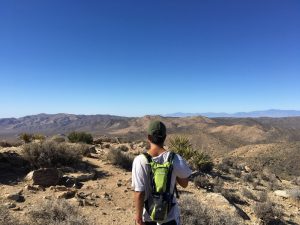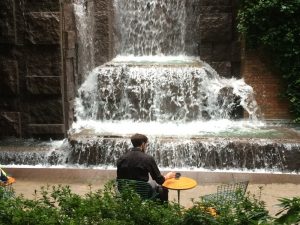
Want to hear more? Join us on October 31st at noon to listen, lunch and learn!
Adjunct Assistant Professor of Music Jin Hi Kim’s Sound Calendar of the Year 2018 is a year-long fusion of art and environmental sound ecology sponsored by the COE’s Faculty-Student Research Grant Program, which provides opportunities for faculty and students to work together on research projects. Harrison Nir ’19 is a composer and double major in music and anthropology. Nir’s work on the sound calendar was funded by a COE Summer Research Fellowship Grant. Psychology and SISP double major Marc Esposito ’20 also worked on the project.
What is the purpose of the Sound Calendar of the Year?
Jin Hi Kim (JHK): Sound Calendar of the Year 2018 (Ecology Sound Calendar) is an expansive environmental audio collection ranging from daily living to contemporary urban life to natural sound environments in multiple geographical locations on planet Earth. The artistic vision was to collect environmental sounds with the hopes of inspiring people to observe the natural and changing sonic atmosphere around us on Earth throughout the year. The project may continuously grow and extend into the enormous possibility of an eternal sound calendar. The purpose and results of the sound calendar will be a balanced juxtaposition between scientific and artistic collaborations on environmental sound.
Harrison, you’re an anthropology and music double major. How did you get involved with the Sound Calendar?
Harrison Nir (HN): I first heard about the Sound Calendar of the Year when an early email went out on the music major listserv about the project. In more ways than one, I felt aligned politically and artistically with the project. I quickly reached out and began my conversation with Jin, who advised I apply for a COE Summer Research Grant as a way to work for the project full-time through the summer! I’m so happy I did. The work has informed my own art making and career building, as a graduating senior.
What did you hope to find in your research?
JHK: I was hoping to discover a range of human urban noise, the timeless sonic landscapes of forests, living environments, unusual sounds, frogs and insect behaviors that have been affected by climate change, as well as sudden sound shifts associated with weather disruptions created by hurricanes, snowstorms, floods, wildfires, or other environmental causations related to global warming. I hoped to find an awareness of and concern for our human environmental living condition and the impact of a changing sonic environment on our living condition.
While collecting these environmental sounds, I hoped that the participants were able to discover the beauty of natural, fractal forms of sonic textures around us. If we pay attention to sound in our environment, we get to appreciate a diversity of sonic forms that are created by nature. An intense flock of birds or insect vocalizations are astounding sonic phenomena and these organic forms of audio textures are indeed so comforting to our neurological system. If we listen to nature, we learn to understand different perceptions of space in contrast listening to composed music or mechanical sounds in a room. We will also realize the impact of manmade noises consistently interrupt our focused energy in current human living condition.
HN: It’s hard to exactly think back to the headspace I was in when my work with the Sound Calendar of the Year began, but I think I wanted most to refine my abilities as a field recordist. After meeting and discussing the project with Jin, I knew I wanted to grow closer to her concept through our collaborative efforts, and to be able to support this project that I felt aligned with. I can honestly say that I achieved both those things and then some.
What did you discover through your research?
JHK: I discovered that there is an extraordinary range of acoustical changes occurring in both our natural and urban environment and that it is impacting both humans but also the animal world. What my team has found is available here:

Were there any surprises?
JHK: Alert and fear! Around the world, 2018 was a year of apocalyptic floods caused by the effects of escalating climate change. This past summer included record-breaking environmental crises around the globe including floods, wildfire, and draught. We are now listening to people’s screams and cries for help from around the world! You may want listen to this sound mix. Fear from climatic disasters created by extreme weather is becoming the new norm. What shall we do to save the planet and make it a better place for us to live?
HN: I found a small-team collaborative environment that was able to operate and develop trans-locally. I found both the independence to be a contributing recordist and a project operations/management intern. I learned about the details of creating a digital sound-art project and I developed my ability to write about the artwork I was a part of.
What are your next steps?
JHK: I need to exhibit some of the Sound Samples, Sound Mixes, and the entire yearlong Sound Calendar of the Year. I anticipate a sound installation with images of locations where the sound was recorded. Hopefully the sound installation and exhibition will inspire the attendees to raise a deeper concern about the environmental issues that the planet is faced with. At the same time the sound installation will create a special space: Imagine you are above the earth and can hear the sounds of any country, simultaneously and timelessly.
Anything else either of you would like to share about the project?
HN: I am so grateful for my time working for the Sound Calendar of the Year, and for the College of the Environment for making that work feasible. Thanks!